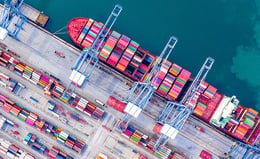What You Need to Know About Amazon's Supply Chain
Keith LaBotz - February 24, 2022

Amazon is revolutionizing logistics, and there's an important lesson your company needs to know for future supply chain success.
We seldom recognize when history is being made, and distinguishing Amazon’s supply chain revolution from the company's evolution isn't so easy either. Amazon’s skyrocketing growth suggests something big is going on and every business needs to understand what's behind it.
What is going on with the Amazon Supply Chain and what does it mean for your company? The answer depends on who you ask. There are countless opinions on the “Amazon Effect,” and how companies should respond. Time will tell which interpretation is correct.
Let's look at a couple of things that differentiate Amazon's approach to logistics and hopefully, it will challenge you to look at things differently. Just like Amazon did.
Amazon Changed the Value Proposition
Turn back the clock ten years, when shipping costs were more expensive than most low-cost products, and delivery took several days. Then Amazon Prime with free next-day delivery changed everything. Amazon became less costly and more convenient than driving to the store with free next-day delivery. The chart above tells the rest of the story.
How was Amazon able to change the value proposition?
Amazon is Committed to Lean Logistics
There is no exciting reveal behind Amazon’s growth. Of course, there is digitalization, AI, and all sorts of innovations at work in Amazon's fulfillment process, but these are merely the end result of Amazon's unrelenting commitment to lean logistics.
What differentiates Amazon is an unconventional perspective which came from an unconventional approach for streamlining fulfillment. While Amazon gets the credit, lean logistics is the unsung hero here.
Lean logistics is nothing new, but Amazon’s commitment to lean logistics is uncommon. Amazon’s leadership principles read like a treatise for continuous improvement and they not only support Amazon’s mission but also foster innovation.
Amazon Leads - It Does Not Follow
Amazon’s principles promote a healthy skepticism towards looking to the majority or authority for the answer. The opposite is encouraged: independent thought, self-responsibility, risk-taking, long-term thinking instead of short-term reaction, and mutual respect for differing opinions.
These ingredients are essential for groundbreaking innovation and the fuel for lean logistics. Amazon looks within for the answers and strives to separate from the safety of the herd. A true leader demonstrates courage and it has nothing to do with one's title.
Amazons Tests Its Beliefs
Amazon’s empire is built with methods and technologies in the public domain. They employ the same tools, skills, resources, and knowledge as countless other companies, but produce wildly different results.
The difference is implementation. Amazon is more effective because it tests beliefs about the supply chain. There's a lot of trial and error in continuous improvement, and an idea is valid until a better one emerges.
The Amazon Supply Chain is like a big lab, testing and revising ideas to find the best solution. Amazon owns and resolves its problems, and this ownership creates a vested interest in the outcome.
Amazon Supply Chain is a Transportation Operation
Amazon Supply Chain is a logistics business morphing into a transportation network. Amazon's expansion into transportation is likely to continue and it's possible Amazon will become the largest transportation provider on Earth.
Why does it matter to your company? I'm not sure of all the implications here, but it appears Amazon's actions and its fulfillment process are validating the roadmap for lower-cost, higher-value logistics in the digital supply chain. Any company can follow this roadmap.
Amazon Fits the Historical Pattern
The Amazon Supply Chain fits in nicely with the evolution of transportation, further blurring traditional lines between logistics and transportation. The global supply chain owes a great deal to transportation innovators who made international trade possible. Asset-based transportation operations extended transportation services around the globe over the past two centuries.
- Jim Casey applied Frederick Taylor’s ‘scientific management” to small package transportation, creating United Parcel Service.
- Malcom McLean invented the standardized shipping container and made international and intermodal transportation scalable.
- Fred Smith’s hub-and-spoke model revolutionized global air freight with FedEx.
- Jeff Bezos inverted transportation, virtually ingesting transportation into the business enterprise, inside of the warehouse, with the Amazon Supply Chain.
Amazon had no choice but to build its fulfillment process around transportation. Given its mission “to be Earth’s the most customer-centric company,” the entire system must optimize around the goal of minimizing delivery cost and time. That's a transportation requirement; transportation is pulling the whole network.
- Transportation management shifted upstream, flipping from the final shipping transaction in fulfillment to the first transaction in order entry.
- Transportation drives the fulfillment process rather than the other way around.
- Transportation is the physical customer interface and e-commerce is its virtual twin.
Lean logistics lead Amazon to build its process around transportation. Others have arrived at the same conclusion, but no one has scaled like Amazon.
Sometimes the best answer is so simple we can't believe it, but Jeff Bezos was not a product of the supply chain status quo. As a computer analyst with an open mind, he learned about fulfillment with a fresh perspective. Bezos also did what few CEOs do - he spent time working in shipping to understand and experience the fulfillment process firsthand. Bezos saw what the customer sees.
Amazon is a blue truck, a driver with a package for Amazon customers. Amazon customers see Amazon as a transportation company with an online marketplace for procuring shipments of products. The Amazon Supply Chain is built to support the customer's perspective and provide the best possible shipping experience.
Amazon ended up de facto recognizing a shipment-centric supply chain model without knowing it. Everything depends upon and sustains the transportation of material goods, data, and capital through the chain.
Conclusion
Funny how things work. The supply chain appears to be returning back to its roots, when transportation, merchant ships and caravans, and the global supply chain were viewed as the same. Maybe that's why Amazon's approach to fulfillment works exceptionally well.
Amazon demonstrates transportation is key for minimizing cost and increasing customer satisfaction in a digital supply chain. flexis supports this approach and you can learn more about it by clicking on the link below.
If you want to learn more get your Guide to Logistics 4.0
In this Guide you will learn:
-
Why a strategic process in transportation planning is a top priority for digitalization
-
What megatrends will increase supply chain volatility
-
How to manage it
Want to learn more about Multimodal Transportation?
Download our presentation and learn:
-
How can transports be planned quickly and yet flexible so that CO2 savings are verifiable?
-
How do you make optimal use of a multimodal transport network that maintains supply in both the short and long term?
-
How can you more easily realize a modal shift when disruptions occur? And how do you keep a grip on your CO2 emissions in doing so?
flexis and BigMile present a Use Case of a modal shift and show that network optimizations and sustainability often go hand in hand.
LATEST POSTS
- Understand Circular Economy in The Manufacturing Industry
- How Can Industry 4.0 IT Integration Be Achieved Smoothly?
- The Significance of Order Sequencing in Discrete Manufacturing
- How to improve your Supply Chain Management: The Power of Control Towers
- Optimizing Human Resource Scheduling in Manufacturing: A Technological Approach




